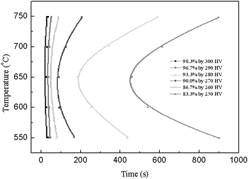Crossref Citations
This article has been cited by the following publications. This list is generated based on data provided by
Crossref.
Shen, Leinuo
Li, Zhou
Dong, Qiyi
Xiao, Zhu
Wang, Mengying
He, Penghui
and
Lei, Qian
2015.
Dry wear behavior of ultra-high strength Cu–10Ni–3Al–0.8Si alloy.
Tribology International,
Vol. 92,
Issue. ,
p.
544.
Shen, Leinuo
Li, Zhou
Dong, Qiyi
Xiao, Zhu
and
Chen, Chang
2016.
Microstructure and texture evolution of novel Cu–10Ni–3Al–0.8Si alloy during hot deformation.
Journal of Materials Research,
Vol. 31,
Issue. 8,
p.
1113.
Si, Li
Zhou, Li
Zhu, Xiao
Sanhua, Li
Leinuo, Shen
and
Qiyi, Dong
2016.
Microstructure and property of Cu–2.7Ti–0.15Mg–0.1Ce–0.1Zr alloy treated with a combined aging process.
Materials Science and Engineering: A,
Vol. 650,
Issue. ,
p.
345.
Sheng, Xiaofei
Lei, Qian
Xiao, Zhu
and
Wang, Mingpu
2017.
Precipitation Behavior and Quenching Sensitivity of a Spray Deposited Al-Zn-Mg-Cu-Zr Alloy.
Materials,
Vol. 10,
Issue. 9,
p.
1100.
Christofidou, Katerina A.
Robinson, K. Jennifer
Mignanelli, Paul M.
Pickering, Ed J.
Jones, Nicholas G.
and
Stone, Howard J.
2017.
The effect of heat treatment on precipitation in the Cu-Ni-Al alloy Hiduron® 130.
Materials Science and Engineering: A,
Vol. 692,
Issue. ,
p.
192.
ZHU, Jia-jun
LI, San-hua
SHEN, Lei-nuo
YANG, Wu-lin
and
LI, Zhou
2017.
Corrosion behavior of novel Cu–Ni–Al–Si alloy with super-high strength in 3.5% NaCl solution.
Transactions of Nonferrous Metals Society of China,
Vol. 27,
Issue. 5,
p.
1096.
Li, Z.M.
Li, X.N.
Wang, C.Y.
Zheng, Y.H.
Yu, Q.X.
Cheng, X.T.
Li, N.J.
Bi, L.X.
Wang, Q.
and
Dong, C.
2019.
Comparative studies on microstructures and properties of Cu–Ni–M alloys controlled by strong interaction between elements.
Journal of Alloys and Compounds,
Vol. 805,
Issue. ,
p.
404.
Dong, B.W.
Jie, J.C.
Wang, S.H.
Dong, Z.Z.
Wang, T.M.
and
Li, T.J.
2020.
Novel insight into precipitation behavior of γ’ phase particles in Cu–15Ni-xAl alloys through Calphad method.
Intermetallics,
Vol. 120,
Issue. ,
p.
106749.
Yang, Ran
Wen, Jiuba
Zhou, Yanjun
Song, Kexing
Niu, Liye
Guo, Huiwen
and
Yu, Yan
2020.
Effect of heat treatment on microstructure and mechanical properties of Cu–6.9Ni–2.97Al–0.99Fe–1.06Mn alloy.
Materials Science and Technology,
Vol. 36,
Issue. 1,
p.
83.
Lu, Ding-ding
Ning, Hong
Du, Yue
Li, Jin-feng
Liu, Dan-yang
Guo, You-jie
Chen, Yong-lai
Zhang, Xu-hu
You, Wen
Zhang, Kai
and
Zhang, Rui-feng
2021.
Detailed investigation of quench sensitivity of 2050 Al-Cu-Li alloy by interrupted quenching method and novel end quenching method.
Journal of Alloys and Compounds,
Vol. 888,
Issue. ,
p.
161450.
Zhao, Qingkun
Yang, Huiya
Liu, Jiabin
Zhou, Haofei
Wang, Hongtao
and
Yang, Wei
2021.
Machine learning-assisted discovery of strong and conductive Cu alloys: Data mining from discarded experiments and physical features.
Materials & Design,
Vol. 197,
Issue. ,
p.
109248.
Li, Z. M.
Li, X. N.
Cheng, X. T.
Hu, Y. L.
Zheng, Y. H.
Yang, M.
and
Dong, C.
2021.
Synergistic reinforcement of Cu–Ni–Al films with dual nanostructure.
Surface Engineering,
Vol. 37,
Issue. 6,
p.
795.
Zhang, Biao
Zhang, Enkuan
Tang, Ying
Wu, Xiaoke
Yi, Wang
Zhong, Jing
and
Zhang, Lijun
2021.
High-Throughput Determination of Composition-Dependent Interdiffusivity Matrices and Atomic Mobilities in fcc Cu-Ni-Al Alloys by Combining Diffusion Couple Experiments with HitDIC Modeling.
Metallurgical and Materials Transactions A,
Vol. 52,
Issue. 6,
p.
2331.
Li, Z.M.
Li, X.N.
Yuan, J.H.
Hu, Y.L.
Zheng, Y.H.
Cheng, Z.L.
Liu, R.W.
Bao, C.M.
and
Dong, C.
2021.
Strong elemental interaction enhances the thermal stability of coherent precipitation strengthened Cu–Ni–Al alloys.
Materials Science and Engineering: A,
Vol. 827,
Issue. ,
p.
141955.
Zhao, Fan
Lu, Qiang
Lei, Yu
and
Liu, Xinhua
2022.
Enhanced cold deformability of a marine Cu-Ni-Al–Fe-Mn alloy produced by HCCM vertical continuous casting: effect of deformation mechanism and second phases.
Philosophical Magazine,
Vol. 102,
Issue. 11,
p.
993.
Tian, Xiaolin
Zhao, Yuhong
Gu, Tao
Guo, Yunlong
Xu, Fengqiang
and
Hou, Hua
2022.
Cooperative effect of strength and ductility processed by thermomechanical treatment for Cu–Al–Ni alloy.
Materials Science and Engineering: A,
Vol. 849,
Issue. ,
p.
143485.
Hu, Y.L.
Li, M.
Hou, Y.D.
Li, X.N.
Li, Z.M.
Cheng, Z.L.
Shao, Y.Y.
Zheng, Y.H.
and
Dong, C.
2023.
Multi-scale-phases coherent precipitation improve the comprehensive performance of heat-resistant Cu alloys.
Journal of Materials Research and Technology,
Vol. 26,
Issue. ,
p.
4706.
Wei, Siyuan
Zhao, Yakai
Li, Shi-Hao
Chen, Shilin
Lau, Kwang Boon
Soh, Verner
Lee, Jing Jun
Zhang, Baicheng
Tan, Cheng Cheh
Wang, Pei
and
Ramamurty, Upadrasta
2023.
Laser powder bed fusion of a Cu-Ni-Al alloy using the compositional grading approach.
Scripta Materialia,
Vol. 231,
Issue. ,
p.
115441.
Yuehong Zheng
Zhu, Sijia
Gao, Haoyang
Tang, Jie
La, Peiqing
Zhan, Faqi
and
Zhu, Min
2023.
Microstructure and Properties of Cu–Ti Alloys Prepared by Aluminothermic Reaction and Subsequent Rolling.
Physics of Metals and Metallography,
Vol. 124,
Issue. 13,
p.
1555.
SHENG, Xiao-fei
HE, Cun-xiao
CHENG, Ya-juan
RAO, Xiao-xiao
and
HE, Guo-ai
2023.
New method and mechanism for quickly obtaining quenching sensitivity temperature range of 7055 aluminum alloy.
Transactions of Nonferrous Metals Society of China,
Vol. 33,
Issue. 1,
p.
36.

 ${[001]_{{\rm{Cu}}}}{\left\| {{{[001]}_{{\rm{N}}{{\rm{i}}_3}{\rm{Al}}}}\left\| {[001]} \right.} \right._\delta }$,
${[001]_{{\rm{Cu}}}}{\left\| {{{[001]}_{{\rm{N}}{{\rm{i}}_3}{\rm{Al}}}}\left\| {[001]} \right.} \right._\delta }$,  ${(110)_{{\rm{Cu}}}}{\left\| {{{(110)}_{{\rm{N}}{{\rm{i}}_3}{\rm{Al}}}}\left\| {(010)} \right.} \right._\delta }$, and
${(110)_{{\rm{Cu}}}}{\left\| {{{(110)}_{{\rm{N}}{{\rm{i}}_3}{\rm{Al}}}}\left\| {(010)} \right.} \right._\delta }$, and  ${(1\bar 10)_{{\rm{Cu}}}}\left\| {{{(1\bar 10)}_{{\rm{N}}{{\rm{i}}_3}{\rm{Al}}}}} \right\|{(100)_\delta }$.
${(1\bar 10)_{{\rm{Cu}}}}\left\| {{{(1\bar 10)}_{{\rm{N}}{{\rm{i}}_3}{\rm{Al}}}}} \right\|{(100)_\delta }$.